Water supply scheme: we build engineering networks
Schemes of water supply networks provide the necessary for life and management of water supply, without which in our time not a single dwelling can do. Axonometric scheme of water supply is the main element of the project, on the basis of which the construction of the system. We will look at the main types of pipe wiring inside and outside the house, and also give a number of useful tips to those who decide to build the network with their own hands.
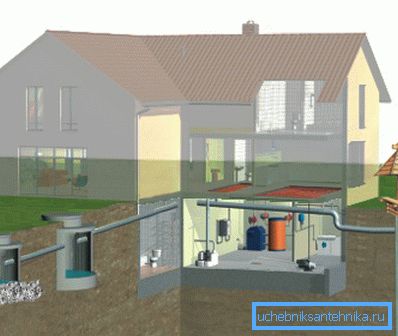
External networks and water sources
Wells and shallow wells

Centralized water supply is the most acceptable option, since you are not required to construct and maintain the entire network, as well as to solve the issue of water extraction. However, not every region has such a convenience, especially when it comes to country houses. Therefore, the first question that confronts the landlord is the question of the source of the water supply.
Here the choice is small - you can realize only two options:
- Drill a well to a pressure aquifer (a so-called artesian well). This is the most acceptable in quality and operation, but also the most complex and expensive option for the construction;
- Dig a well or drill a shallow well (the so-called “sand” well). Here the costs are minimized, a well or an Abyssinian well can be built independently, no permits and special equipment is required.
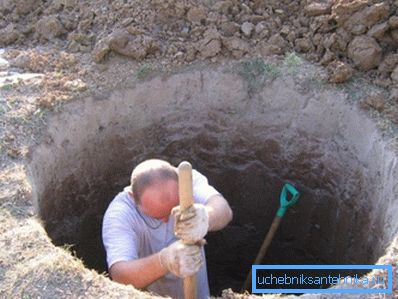
In this chapter, we will look at the second option — a well and a shallow well. In fact, the differences between these options are reduced only to the method of opening the aquifer, and the water quality in both cases is about the same. The well is considered somewhat safer because of the greater depth and closed mouth.
It is easiest to dig a well using reinforced concrete rings: first, a shovel digs a shallow hole to fit the ring, then lower the first ring into it, level it, and start digging. As it descends, the following is added on top - and so on. This is the easiest and safest method.

The well on the sand is also not very complex, however, drilling equipment and specialist participation are already required. Today there are many enthusiasts who drill such wells themselves, moreover, some of them even create homemade drilling rigs, but this is the exception rather than the rule.
The Abyssinian well (or the Abyssinian well) is the simplest in independent execution. In fact, it is a pipe with a sharp tip, which pierce the ground to the aquifer. Water begins to penetrate into the holes in the walls at the bottom of the pipe, and with the help of a pump it can be taken out and sent to the house.

In wells and shallow wells, water is not of high quality, as there is an exchange with surface fluid, especially during floods and seasonal melting of snow. In addition, the thickness of the natural filter ranges from 4 to 30 - 40 meters, which is not so much.
Another drawback is a rather limited resource. With the active consumption of a large family with a farm, such a source can be depleted in 5 to 20 years. Of course, there are many examples of years of service, but this feature should be taken into account.
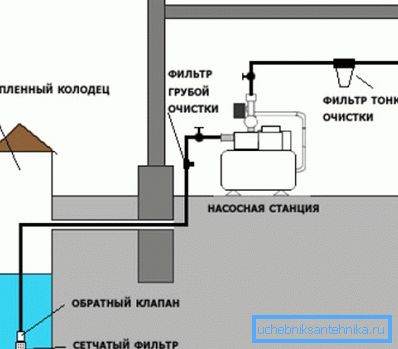
Finally, shallow wells require constant operation, otherwise they are silted up and stop working. Wells are also concerned, but they can be cleaned and re-operated, but with wells it is much more difficult to do.
Note! Wells and wells in the sand are cheap and easy to build, but the quality of their water leaves much to be desired. For use in food such water requires careful cleaning and preparation.
Artesian wells
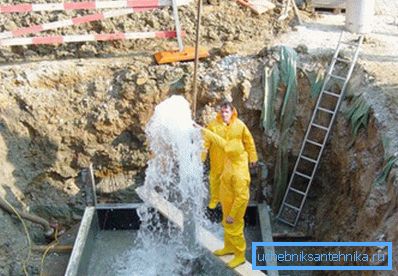
If you want to have a high quality water source - then you should choose an artesian well. This species is distinguished by the fact that the water rises from a considerable depth - 50 - 150 meters from a limestone aquifer. Before getting into this geological horizon, the liquid passes a huge way, gradually being cleaned of impurities and filtered.
In addition, due to contact with various types of soils and rocks, water is mineralized, which is very useful for our body. Often mineralization can be too high, but this problem is solved by using chemical filtering.

For the development of artesian sources, permission is needed, and work can only be done by a specialized organization. In addition, in the event of a horizon pollution, you will be legally responsible to the state.
Advantages of artesian sources:
- High degree of water purification due to natural filtration. The liquid passes through a large thickness of rock of varying degrees of permeability and is completely cleaned;
- High quality water in terms of mineral composition. The liquid is enriched with a large number of minerals present in the soil;
- In most cases, limestone horizons are under great pressure, and the water rises to the surface itself. This eliminates the need for serious pumping equipment and simplifies system maintenance;
- The resource of the deep lakes is practically inexhaustible, therefore the service life of the source is much longer than at the well;
- Artesian wells are characterized by high performance, so you can build one point of water production in several adjacent areas. This will significantly reduce costs.
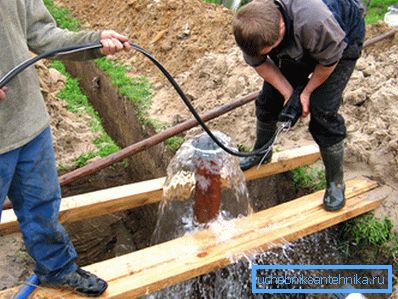
Note! A significant disadvantage of all artesian sources is the high cost of their construction and the need for obtaining permits from state supervisory authorities and sanitary services.
Internal networks
Tee layout
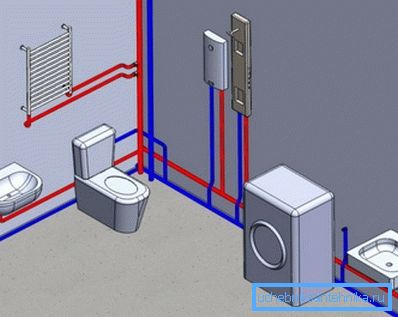
The most common method of distributing the internal pipes of the water supply system is a sequential or tee circuit. It differs in that all devices are connected in series.
Usually the system is organized like this:
- There is a hot and cold water riser, which is connected directly to the main line;
- Horizontal pipes or sun beds branch off the riser on each floor through a tee. Most often used lower wiring when the lounger is on the floor or in the screed;
- Further from the lounger, through the tees, the liner pipes are drained to each device.
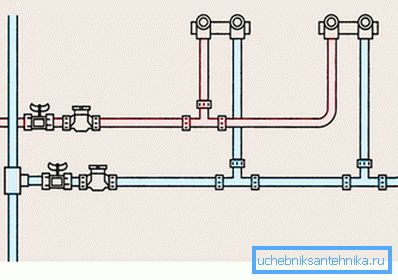
Note! With such a pipe layout consumption of building materials will be minimal. The volume of installation work is also small, respectively, the cost of the project will be lower.
However, there is one major drawback: with simultaneous switching on of two or more water intake devices (a tap in the kitchen and a shower in the bathroom), the water pressure drops noticeably, respectively, less liquid will flow into each device. Also on the most remote cranes, the pressure will be significantly lower than that of the ones located near the riser.
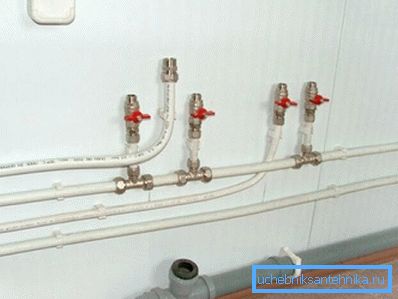
This feature is not so essential for small houses or city apartments. However, for large mansions and cottages with many rooms and bathrooms, this disadvantage will be noticeable and will reduce the comfort of operating water supply.
Collector wiring

For large houses and multi-room apartments with several bathrooms, collector distribution of water pipes is more often used. It differs in that the liner from the riser to each sanitary device separately.
As a result, when two or more valves are switched on simultaneously, there is no noticeable pressure drop in the system. In the case of a large number of residents and large areas of the room, this feature is important and even decisive when choosing a water supply scheme.
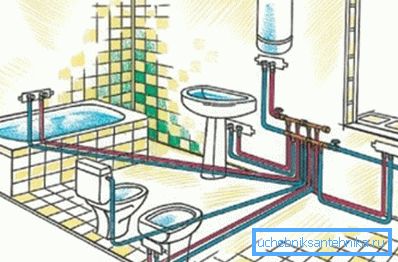
Another advantage of the system with collector wiring is the ability to disconnect any device from the water supply without interrupting the supply of fluid to the other points of the water intake. In the case of breakdowns and repairs, as well as the replacement of plumbing, this feature is quite important.
The disadvantages of such a system include the following qualities:
- For the implementation of the system requires a much larger number of pipes, fittings and other equipment;
- The construction of the system is more complex and time consuming;
- Requires collector unit and sanitary cabinet. Sometimes a basement or a separate room is used instead of a closet;
- The circuit requires the use of a pressure reducer.
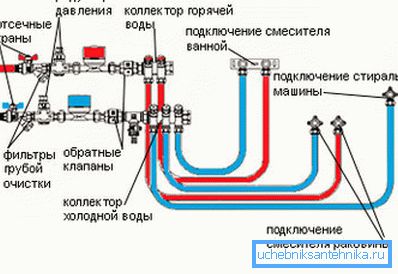
You can also note that the instruction involves the use of more expensive plastic pipes. In addition, a large number of horizontal sun loungers must be hidden somewhere, and this requires either special decoration or wall shading. You can also hide the pipes in the floor screed during the rough finish.
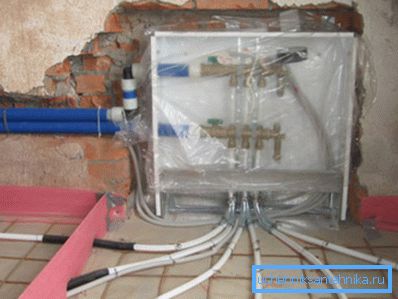
Note! Plumbing with collector wiring has a higher cost and complexity in the construction. However, for large houses and cottages there is no better alternative.
Conclusion
The plumbing system can be organized in various ways. After reading the article, you will be able to determine what is the best-collector or tee-line scheme of the aqueduct, as well as choose a suitable water source. The video in this article will help you put into practice your home water supply project.